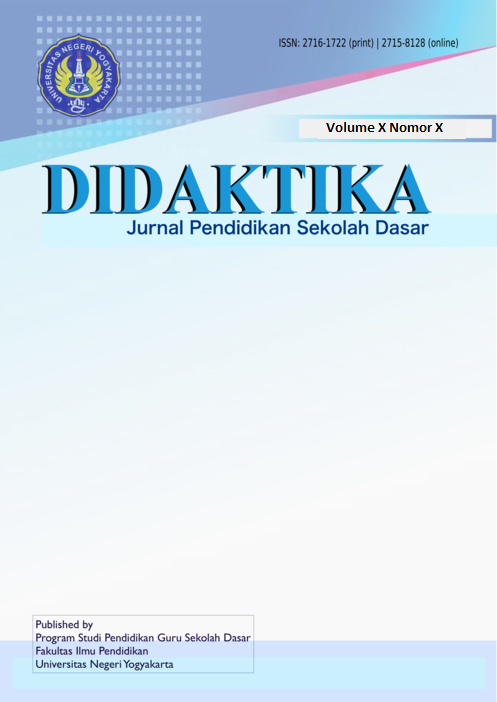Pengembangan Media Pembelajaran Audio Visual Tema Daerah Tempat Tinggalku di Sekolah Dasar
DOI:
https://doi.org/10.21831/didaktika.v3i1.28134Abstract
This research was conducted in class IV of Kepatihan Elementary School 01 Jember with 38 research subjects. The purpose of this study is to describe the process and find out the results of the development of audio visual as learning media with the theme of my residence area on the 4th grade students at SDN Kepatihan 01 Jember. This type of research is research and development. Type model uses ADDIE (Analyze, Design, Development, Implementation, Evaluation). The data analysis technique in this study used a validation sheet of audio visual learning media by the media expert validator and the material expert validator, and student learning outcomes assessment sheets and student responses. The results of the research data analysis showed the effectiveness of the results of the validation carried out by the two validators obtained results of 81,7 while the results obtained from the student learning outcomes test were 94,7% and student responses amounted to 73,7% so that it can be concluded that the audio-visual learning media has very fasible and effective criteria try out.
Keywords: Audio visual, learning media, elementary school
References
Anwariningsih, S., H, Ernawati. S., (2013). Development of Interactive Media for ICT Learning at Elementary School Based on Student Self Learning. Journal of Education and Learning. Vol.7 (2) pp. 121-128.
Arsyad, A. (2013). Media Pembelajaran. Cetakan ke-16. Jakarta: PT Raja Grafindo Persada.
Daryanto. (2016). Media Pembelajaran. Cetakan Pertama. Yogyakarta: PT.Gava Media.
Diansari, A., A., Bambang S., Adi, S., (2017). The Effect of Problem-Based Learning Model, Learning Audio Visual Media and Internship on Student's Soff Skill. International Journal of Academic Research in Business and Social Sciencest.. 7(9). 333-341. DOI: 10.6007/IJARBSS/v7-i9/3329.
Fuady, R., Ariffin, A., M., (2018). Audio-Visual Media in Learning. Journal of K6, Education and Management. 1(2) 1-6.
Masyhud, S. M. H. (2014). Metode Penelitian Pendidikan. Edisi Keempat. Jember: Lembaga Pengembangan Manajemen dan Profesi Kependidikan (LPMPK).
Masyhud, S. M. H. (2016). Metode Penelitian Pendidikan. Jember: LPMPK.
Nieveen, N. (1999). Prototyping to Reach Product Quality. Dalam Plomp, T; Nieveen, N; Gustafson, K; Branch, R.M; dan van den Akker, J (eds). Design Approaches and Tools in Education and Training. London: Kluwer Academic Publisher.
Sarwinda, K., Eli R., Mirra, F. (2020). The Development of Audio-Visual Media with Contextual Teaching Learning Approach to Improve Learning Motivation and Critical Thinking Skills. Psychology, Evaluation, and Technology in Educational Research. 2(2). 100-117.
Tegeh, I. M., I. N. Jampel, dan K. Pudjawan. (2014). Model Penelitian Pengembangan. Yogyakarta: Graha Ilmu.
Downloads
Published
How to Cite
Issue
Section
Citation Check
License
- Authors retain copyright and grant the journal right of first publication with the work simultaneously licensed under a Creative Commons Attribution License that allows others to share the work with an acknowledgement of the work's authorship and initial publication in this journal.
- Authors are able to enter into separate, additional contractual arrangements for the non-exclusive distribution of the journal's published version of the work (e.g., post it to an institutional repository or publish it in a book), with an acknowledgement of its initial publication in this journal.
- Authors are permitted and encouraged to post their work online (e.g., in institutional repositories or on their website) prior to and during the submission process, as it can lead to productive exchanges, as well as earlier and greater citation of published work.






